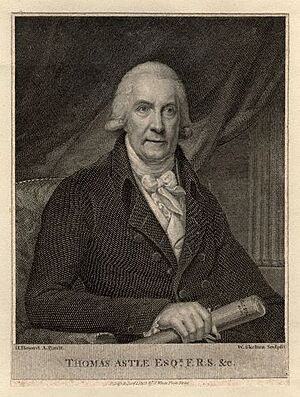Thomas Astle facts for kids
Thomas Astle (born December 22, 1735 – died December 1, 1803) was an English expert in old things and ancient writings. He was known as an antiquary and a palaeographer. An antiquary studies old objects and history, while a palaeographer studies ancient handwriting. Thomas Astle became a member of important groups like the Society of Antiquaries and the Royal Society. These groups are for people who are very good at science and history.
Contents
Who Was Thomas Astle?
Thomas Astle was born in a place called Yoxall in Staffordshire, England. His father, Daniel Astle, was in charge of Needwood Forest. Thomas first trained to be a lawyer, but he decided not to follow that path. Instead, he moved to London. There, he helped create an index for a big collection of old papers called the Harleian manuscripts. This job showed his talent for organizing historical documents.
Astle's Important Roles
In 1763, Thomas Astle became a member of the Society of Antiquaries of London. Around this time, a famous politician named George Grenville hired him. Astle's job was to help sort out important papers that needed someone who understood old handwriting. He was even part of a special group that looked after public records in Westminster.
Later, in 1766, Astle also joined the Royal Society, which is a very old and respected group for scientists. They chose him because he was "greatly Conversant in the study of the Antiquities of this kingdom," meaning he knew a lot about England's old history.
The House of Lords, part of the British Parliament, asked Astle for his advice on printing old government records. He suggested his father-in-law, Philip Morant, for the job. When Morant passed away in 1770, Astle took over this important work. He also became the chief clerk at the Record Office in the Tower of London in 1775. Then, in 1783, he became the main Keeper of the Records there.
Astle's Family Life
In 1765, Thomas Astle married Anna Maria Morant. She was the only daughter of the Reverend Philip Morant, who was a historian of Essex. When her father died in 1770, Anna Maria inherited his large library of books and old papers, along with a lot of money.
Thomas Astle passed away on December 1, 1803, at his home near London. He was 68 years old. He and Anna Maria had nine children together. Some of his children included Philip Hills, Edward Astle, Maria Bloxham, and a naval officer named George Astle. Thomas Astle is buried at St Mary's Church, Battersea, where there is a special monument to remember him.
Thomas Astle's Collections and Books
Thomas Astle managed to gather one of the most amazing private collections of old manuscripts in England. Manuscripts are documents written by hand, often very old and rare. He helped other historians, like Thomas Percy, who was studying old songs and poems called ballads.
Astle also helped with several important publications. He worked on The Antiquarian Repertory and wrote articles for Archaeologia and Vetusta Monumenta, which are publications of the Society of Antiquaries. His work included a study of old Scottish seals.
Astle's Published Works
Astle wrote several important books and articles:
- The Will of King Henry VII (1775): This book reproduced the will of an old English king.
- The Origin and Progress of Writing (1784): This was his most famous work. It explored how writing developed, from picture-based writing (hieroglyphics) to the letters we use today. It also included information about the history of printing. The book had many detailed pictures.
- An Account of the Seals of the Kings, Royal Boroughs, and Magnates of Scotland (1792): This book focused on the official seals used by Scottish kings and important people.
Astle's main work, The Origin and Progress of Writing, was very important for understanding the history of handwriting and documents. He was a dedicated and careful keeper of records, always working to store and organize them better.
What Happened to His Collections?
After Thomas Astle died, his collection of printed books was bought by the founders of the Royal Institution in 1804. His amazing collection of handwritten manuscripts was given to the Marquis of Buckingham. This was a sign of Astle's respect for the Grenville family. The Marquis even built a special room at Stowe House just to keep these valuable manuscripts safe.


